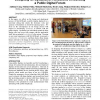Free Online Productivity Tools
i2Speak
i2Symbol
i2OCR
iTex2Img
iWeb2Print
iWeb2Shot
i2Type
iPdf2Split
iPdf2Merge
i2Bopomofo
i2Arabic
i2Style
i2Image
i2PDF
iLatex2Rtf
Sci2ools
CHI
2008
ACM
2008
ACM
Designing for bystanders: reflections on building a public digital forum
In this paper, we reflect on the design and deployment process of MAGICBoard, a public display deployed in a university setting that solicits the electronic votes and opinions of bystanders on trivial but amusing topics. We focus on the consequences of our design choices with respect to encouraging bystanders to interact with the public display. Bystanders are individuals around the large display who may never fully engage with the application itself, but are potential contributors to the system. Drawing on our recent experiences with MAGICBoard, we present a classification of bystanders, and then discuss three design themes relevant to the design of systems for bystander use: graduated proximal engagement, lowering barriers for interaction and supporting covert engagement. ACM Classification Keywords H5.m. Information interfaces and presentation (e.g., HCI): Miscellaneous. Authors Keywords bystanders, large display groupware, large displays, mobile computing, sms
Authors Keywords Bystanders | CHI 2008 | Encouraging Bystanders | Human Computer Interaction | Large Display Groupware |
| Added | 30 Nov 2009 |
| Updated | 30 Nov 2009 |
| Type | Conference |
| Year | 2008 |
| Where | CHI |
| Authors | Anthony Tang, Matthias Finke, Michael Blackstock, Rock Leung, Meghan Deutscher, Rodger Lea |
Comments (0)

